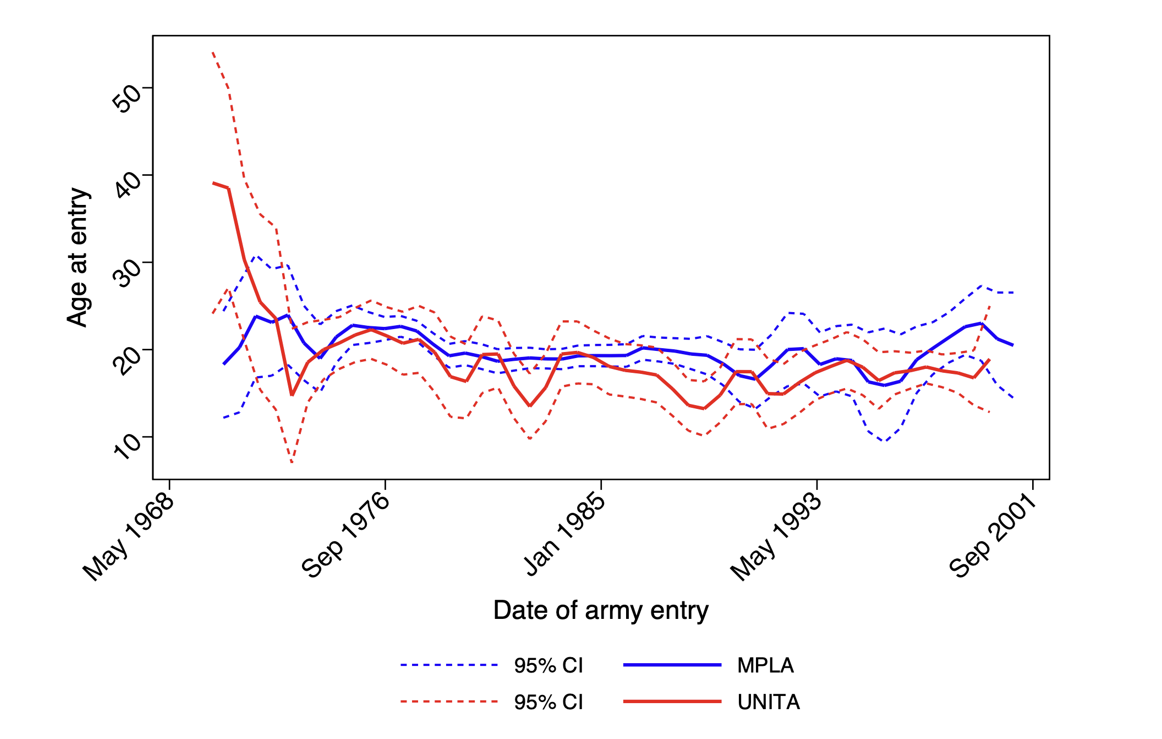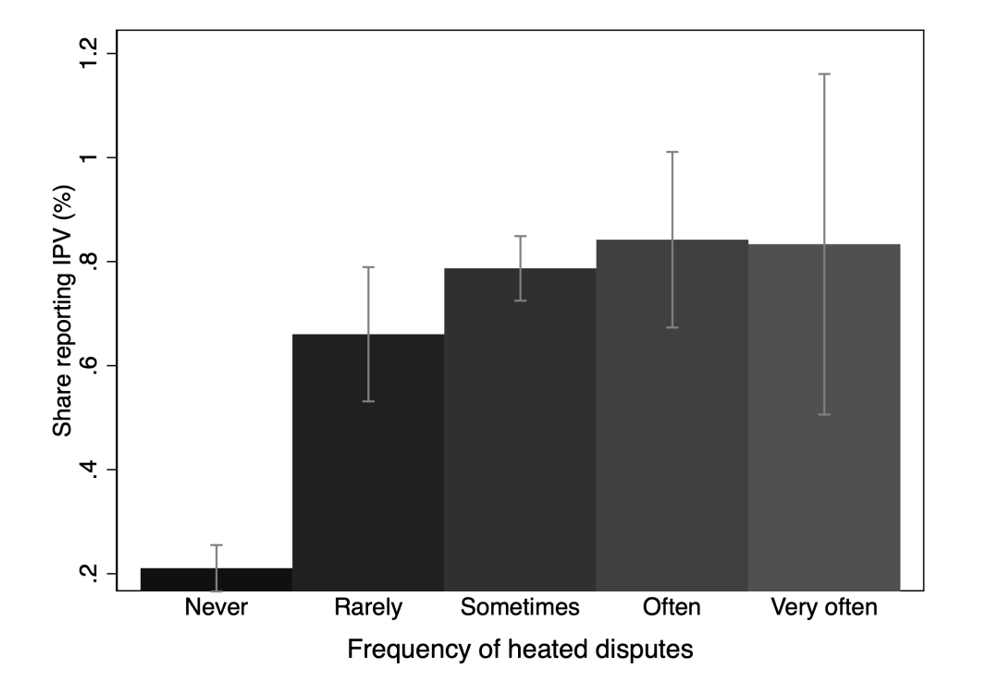
Angolan war veterans exposed to sexual violence during the war are more likely to be violent to their wives in the post-war period
Why do so many men harm their intimate partners? Globally, one in three women experience intimate partner violence (IPV) in their lifetime (Devries et al. 2013), creating enormous risks for victims and future generations (Pollak 2004, Aizer 2011, Sabia et al. 2013). The estimated welfare cost of domestic violence is about five times that of wars (Fearon and Hoeffler 2014). However, identifying reliable policies for preventing and reducing domestic violence is proving difficult. A central limitation is that the individual-level factors that lead men to commit violent acts against their intimate partners are not well understood.
In recently-published research (Stojetz and Brück 2023), we propose and test a causal long-term link from past exposure to wartime sexual violence to contemporary violent behaviour against the intimate partner. Informed by historical and ethnographic insights, we use novel survey data from Angolan war veteran families to demonstrate that exposure to sexual violence by armed groups causally increases men’s propensity to commit IPV in the post-conflict period. This effect holds 12 years and more after these gruesome war events took place, indicating how long the shadow of war can be.
Our results are not consistent with standard explanations of IPV based on group norms and intra-household bargaining. Instead, we attribute the effect to a lasting reduction in self-control skills. These findings challenge standard approaches to preventing IPV and emphasise the potential of working with men, especially after episodes of collective political violence.
From wartime sexual violence to post-war intimate partner violence
We study the impact of exposure to wartime sexual violence for two main reasons. First, perpetrating or witnessing violence is often associated with engaging in violent behaviour in the future – ‘violence begets violence’ (Pollak 2004, Littman and Paluck 2015). Second, sexual violence is among the most intense, recurring and abhorrent forms of gender-based violence and war atrocities, affecting millions of people across the world as victims and perpetrators. Starting with events in Bosnia and Rwanda, awareness for wartime sexual violence in the global policy discourse has increased rapidly, and United Nations Security Council Resolution 1820 recognises that “rape and other forms of sexual violence can constitute war crimes, crimes against humanity or a constitutive act with respect to genocide” (UN 2008, 3). Nonetheless, armed groups around the world continue to perpetrate sexual violence, including contexts as diverse as Liberia, Eastern Congo, Colombia, Timor–Leste, Pakistan, or Iraq and Syria (Cohen et al. 2013).
Theoretically, it is unclear whether a man’s exposure to collective sexual violence against women increases or decreases his long-run propensity to commit IPV. (Note that we do not differentiate between committing such acts versus witnessing them, as we cannot separately measure these two forms of exposure empirically.) We study five potential mechanisms: a shift in traditional norms of gender identity and relations, the creation of violent models, a decrease in self-control, psychological distress, and a reduction in intra-household bargaining power.
Context and data
Testing the causal net relationship and the underlying mechanisms presents considerable data and identification challenges. High quality micro-level data on conflict experiences beyond exposure to battle-field violence are scarce. Additionally, unobserved individual-level factors may vary simultaneously with wartime exposure to sexual violence and domestic violence today.
To overcome these data challenges, we collected detailed primary survey data on exposure to wartime sexual violence from 578 Angolan war veterans and matched data on IPV today from their intimate partners as part of a larger mixed-method research project. Our survey dataset includes detailed information on war and military service experiences, pre-service background characteristics and post-war social behaviours in 2014. The questionnaire was strongly informed by twelve months of ethnographic research into social behaviours and wartime experiences among ex-combatants in Huambo province in Angola (Spall 2015).
To establish causality, we rely on a natural experiment in Huambo province, the epicenter of the 1975-2002 Angolan Civil War. The politics and dynamics of the Angolan war created as-if random variation in how likely it was that an individual soldier would be exposed to wartime sexual violence against women that was beyond the individual soldier’s sphere of control or his observable characteristics.
The war was characterised by mass militarisation and military competition between two high-capacity actors, the Movimento Popular de Libertação de Angola (MPLA) government and the União Nacional para a Independência Total de Angola (UNITA) rebels. Throughout the war, both sides used their institutional capacity to enforce compulsory military service for all men in their late teenage years in territories under their control (Figure 1).
Figure 1: Age of recruitment over time

Historical accounts document that control of local territory during the war shifted frequently in Huambo province and concludes generally that “a person’s first contact with any political formation was as likely to have been with UNITA as with the MPLA” (Pearce 2012, 463). Pearce (2009, 4) adds that “political identity was a matter of necessity rather than of conviction. It is for this reason that I use the word ‘adherent’ rather than ‘supporter’ when referring to the people who lived under the control of one or other movement during the war, since ‘support’ suggests a degree of voluntary affiliation which misrepresents the relationship.”
As a consequence, universal conscription exogenously assigned individuals into different military entry dates (based on their date of birth) and different armies (due to shifts in territorial control). Crucially, the extent of wartime sexual violence exerted by an armed group varied strongly over time and armed group. Therefore, for a specific subset of the army and date of birth combinations the ex-ante risk of exposure to sexual violence against civilian women was much higher for some men than for all other men, all other things being equal.
Key findings
Three of our findings are particularly noteworthy:
1. There is a lasting connection between war-time exposure to sexual violence and post-war propensity to commit IPV.
Soldiers in Angola who were exposed to situations of sexual violence against civilian women during the war are up to 30 percentage points more likely to be violent to their partners compared to soldiers who were not exposed to such situations. Notably, this effect is confined to physical, not sexual, intimate partner violence.
2. The underlying mechanism in the increased propensity is a reduction in self-control.
We argue that the underlying mechanism is a lasting reduction in self-control skills, fostering more impulsive and automatic responses to critical situations with their partner, as indicated by Figure 2, which shows that IPV incidence reported by spouses increases with the reported frequency of heated disputes.
Figure 2: Heated disputes and intimate partner violence

3. Acts of IPV in post-conflict situations can be expressive behaviour.
Perhaps surprisingly, we find no support for alternative theories based on living up to norms of gender, social models of violence, distress, or a reduction in economic bargaining power, which have dominated explanations of intimate partner violence across disciplines. Our findings are consistent with an interpretation of IPV as ‘expressive’ behaviour, where men intrinsically value the expression of violence and/or violent acts may arise as an unintended outcome.
Designing more effective interventions
Our findings have important implications for designing effective interventions to reduce and prevent IPV prevalence in post-war settings. In developing countries, policies aimed at reducing rates of IPV have predominantly been victim-centered. Our findings emphasise the need for also paying attention to perpetrators and the factors internal to them that precipitate violent acts, especially in post-conflict countries. Working with affected and at-risk males may offer a fruitful additional route to reduce and prevent IPV by treating an underlying driver of IPV.
In addition, a large class of programmes and interventions seeks to strengthen social cohesion in post-conflict societies. It has been shown that conflict legacies can last for decades (Verwimp et al. 2019), and that both social and psychological factors need to be taken into account to deliver support that is both responsible and effective (Cilliers et al. 2016). Specifically, post-conflict reintegration programmes for perpetrators often assume that former combatants pose a threat to political stability and focus on individual-level economic assistance to demobilised soldiers (Gilligan et al. 2013). Our study exposes important stability threats at the family level and can inform future assistance, tailored to and addressing the psychological conflict legacies carried by veterans, which is crucial to their own and their families’ well-being. In fact, the negative impact channel we detect might be mitigated by innovative forms of psychotherapy which have been shown to reduce criminal and violent behaviours (Blattman et al. 2023).
References
Aizer, A (2011), “Poverty, Violence, and Health the Impact of Domestic Violence during Pregnancy on Newborn Health”, Journal of Human Resources 46(3): 518–538.
Blattman, C, S Chaskel, JC Jamison, and M Sheridan (2023), “Cognitive Behavioral Therapy Reduces Crime and Violence over Ten Years: Experimental Evidence”, American Economic Review: Insights, 5(4): 527-545.
Cilliers, J, O Dube, and B Siddiqi (2016). “Reconciling after civil conflict increases social capital but decreases individual well-being”, Science 352(6287): 787–794.
Cohen, D K, A Hoover Green, and E J Wood (2013), “Wartime Sexual Violence: Misconceptions, Implications, and Ways Forward”, Special Report 323, Washington, DC: United States Institute of Peace.
Devries, K M et al. (2013), “The Global Prevalence of Intimate Partner Violence against Women”, Science 340(6140): 1527–1528.
Fearon, J D and A Hoeffler (2014). “Benefits and Costs of the Conflict and Violence Targets for the Post-2015 Development Agenda”, Conflict and Violence Assessment Paper, Copenhagen Consensus Center.
Gilligan, M J, E N Mvukiyehe, and C Samii (2013), “Reintegrating Rebels into Civilian Life: Quasi-experimental Evidence from Burundi”, Journal of Conflict Resolution 57(4): 598–626.
Littman, R and E L Paluck (2015). “The Cycle of Violence: Understanding Individual Participation in Collective Violence”, Political Psychology 36(1): 79–99.
Pearce, J (2009), “Global Rivalries and Local Politics in the Angolan Central Highlands”, Paper for the Working Expert Seminar on Southern Africa in the Cold War Era, LSE Cold War Studies Centre.
Pearce, J (2012), “Control, Politics and Identity in the Angolan Civil War”, African Affairs 111(444): 442–465.
Pollak, R A (2004), “An Intergenerational Model of Domestic Violence”, Journal of Population Economics 17(2): 311–329.
Sabia, J J, A K Dills, and J DeSimone (2013), “Sexual Violence against Women and Labor Market Outcomes”, American Economic Review 103(3): 274–278.
Spall, J (2015), The Ethics of Manhood in Post-war Huambo, Angola. Ph.D. thesis, University of Sussex.
Verwimp, P, P Justino, and T Brück (2019), “The Microeconomics of Violent Conflict”, Journal of Development Economics 141: 102297.
UN (2008), Security Council Resolution 1820 (S/RES/1820). New York: United Nations Security Council.


